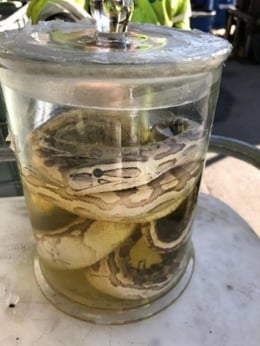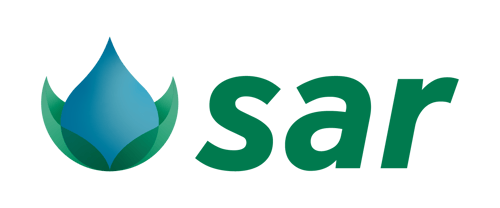Hazardous waste can be many things, and this time it was a rare variant of actual snakes preserved in alcohol.
We recently received a shipment of snakes that were preserved in alcohol, which was an unusual delivery of hazardous waste for our operators. While we are accustomed to receiving hoses containing different types of oil, receiving actual snakes in alcohol was a new experience. These snakes had been in a museum for many years before ending up at our SAR Tananger facility.
 Since they had been dead for a long time, releasing them into nature was not a viable solution.We identified the substance number they fell under and determined that energy recovery through incineration was the appropriate treatment solution.
Since they had been dead for a long time, releasing them into nature was not a viable solution.We identified the substance number they fell under and determined that energy recovery through incineration was the appropriate treatment solution.
It's important to remember that there are many items we may not initially think of as hazardous waste, but still require proper treatment.
To help with this, we have compiled some useful information on hazardous waste, including its definition and the importance of correctly sorting and treating it:
|
This is hazardous waste: Hazardous waste, formerly known as special waste, refers to all waste that cannot be treated together with ordinary waste. The reason for this is that they have properties that can lead to serious pollution or harm to humans or animals. |
Strict regulations and increased attention
While hazardous waste has always existed, it was not until the implementation of the Regulations on Systematic Health, Environment, and Safety Work in Enterprises in 1997 that it received proper attention.
Hazardous waste is not just limited to substances that are toxic or corrosive, but encompasses a wider range of materials. In the case of the preserved snakes, their hazardous classification was based on the harmful environmental impact of the liquid they were preserved in.
Examples of hazardous waste that may seem harmless
Although certain forms of waste may appear benign, they can pose a threat to humans, animals, and the ecosystem if not managed appropriately, such as hazardous waste
- Insulation can be considered hazardous waste either because it contains harmful substances or because it generates high levels of dust that can harm the respiratory system. Consequently, special packaging requirements apply to insulation to ensure safe handling and disposal.
- Gas pipes that have been used for gas production may appear empty and clean, but can still emit radioactive radiation due to the gas that previously passed through the pipe. The pipes are then hazardous waste and cannot be sent in as metal.
- Infectious waste (including sharp and cutting waste), by definition, is not hazardous waste, but should be handled as if it were hazardous waste. The waste has special packaging requirements and transport requirements (dangerous goods).
- Flares are classified as explosives, and as such, they must be returned to the manufacturer, importer, or distributor. If flares are mixed with other waste, it can lead to severe incidents, such as fires and injuries to individuals at the waste reception facility.
- Gas containers, both large and small, are considered hazardous waste due to being pressurized, even if they contain harmless gases. It is important to never mix gas containers with other waste, including fire extinguishers which may also contain hazardous substances. Even smaller pressurized containers such as spray cans, whether they contain flammable spray adhesive or whipped cream, are still considered hazardous waste.
- Empty packaging with residues - To be considered regular waste, packaging must be completely empty, without any film, and cleaned if it previously contained hazardous waste.
- Wash water can contain hazardous substances like heavy metals in the cleaning agents and equipment being washed, and the soap itself may have corrosive properties.
- Fluorescent tubes often contain mercury gas, making them hazardous waste. It is crucial to handle these tubes carefully to avoid breakage and exposure.
- Wood may be treated with hazardous substances such as old paint or various types of impregnation that contain heavy metals.
What are the potential consequences of disposing hazardous waste with regular waste?
In order to protect the environment, animals, and humans, there are strict regulations in place for the handling, packaging, classification, declaration, labeling, and transportation of hazardous waste. Additionally, permits ensure that waste treatment is conducted safely and within set limits for emissions.
However, if hazardous waste is mixed with regular waste, there is a lack of control over how it is treated. The facility responsible for treating the waste may not have the necessary permits or systems in place to handle hazardous waste. As a result, the hazardous waste may not be treated properly and can pose a significant risk. It is important to note that hazardous waste and regular waste are treated differently.
What happens when hazardous waste is mixed with regular waste?
In the event that hazardous waste is mixed with regular waste, there can be several negative consequences for the environment, human health, and safety.
For instance, grinding up and burning hazardous waste alongside regular waste can result in the release of hazardous gases, causing environmental pollution.
Additionally, the combination of hazardous materials and friction/heat from grinding can lead to fires or explosions. Human health can also be impacted, as waste facility workers may be unaware of the hazardous contents and suffer injury or illness as a result.
Promote sustainability and environmental protection
It is crucial for individuals and businesses to have control over their waste management. This ensures that waste is handled and treated in a safe, cost-effective, and environmentally-friendly manner, which is beneficial for both the business and the environment.
For more information on consulting and environmental services, feel free to contact SAR.




